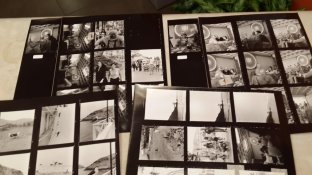getting back to the OP
I started shooting film a couple of months ago with a Pentax SPII without a working light meter and seemed to be getting decent exposures based on the scans of the negatives I was getting(done by the lab). I've recently started doing some black and white myself and did my first contact sheet the other day having just printed a select couple of frames previously. I noticed that the exposures seem to be all over the place with some of the contact print images being very dark and a couple very light. However on the negatives there still seems to be plenty (probably?) of detail.
I assume the lab must have been correcting the scans? Are the differences on the contact sheet just because my guesses at EV are wrong (I think so)? Could it be that I still have all the information due to the film's exposure latitude? What benefit would buying a light meter have if the exposures still have all the information? Would it just allow easier printing as I wouldn't need to do test strips for every frame?
hi carriage:
i'd get a light meter, and learn how to use it. i would also take your camera to a repairperson ( if you haven't already )
and have it cleaned, adjusted and lubricated to make sure
your shutter speeds are accurate. its not worth getting frustrated about your exposures
and processing being off when you are first learning the ropes ..
get comfortable with exposing ( pay attention to the light and what your meter says,
and the scene ) and process your film. one thing you might also do is
bracket your exposures in case your light meter is a little off. take a roll of film,
and make 3 exposures 1 as the light meter says, 1 1stop over and 1 1stop under ( like f8, 11, 5.6 )
( or you can adjust your shutter speed since they are all interconnected ( 1/125S, 1/60 (over), 1/250(under) )
and process your film the way you learned ( agitation, dilution and time ). contact print your film
( or whatever method you use to get your positive imaves ) and see which exposure works best for you
and your developing and printing methods ... and adjust your meter to agree with whatever ISO you choose
that makes your negatives look the best ( 400, 200 (over), 800 (under) )
if down the road you want to try to not use your meter again,
since you have been paying attention to the light and learning the light as you use your meter, it won't be as difficult
.. and your exposures might not be as all over the charts as they seem to be.
good luck !
john




